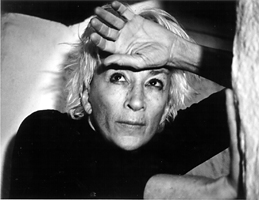This is part two of a three-part series (see part one) from award-winning dance performer and director Ruth Zaporah. At age 17, Ruth’s father gave her Autobiography of a Yogi to read. Ever since, she has maintained her devotion to both Eastern and Western practices and understandings of the mindful process, and has applied them in her innovative work in physical theater improvisation training. “A Mind in Three Episodes” is excerpted from her new memoir, Improvisation on the Edge.
~~~
Like meditation, dance needs no accompaniment.
It is a silent language. Stepping onto a studio floor always invites a shift of mind, a descent into a calm lake far away from the torrents of life, school, family, friends, and everything else. So when I first entered a meditation hall at age twenty-two after many years of dancing, there was something familiar and comfortable about it; here was another silent and still place.
Dance is a silent language, but is it a language of stillness? Absolutely.
Every gesture, each leap, lift, swirl, and twirl are all actions that emanate from stillness and are experienced within that context, consciously or not. In a clear-sky moment, all actions generate from and are contained within a still mind.
The body bends, just a tiny bit. That’s all.
It’s a small thing, just a slight bend. However, this bending has the potential to fill the moment completely, leaving no room for disturbance, distraction, evaluation, hesitation, or doubt.
The little bend is everything.
And the bend is also nothing.
On its own, it doesn’t offer us anything to think about, or name, or have an opinion about. It just is, as it is. A slight bending of the body.
Now my voice wails as I bend. The sound is low and guttural. My mood shifts to a corresponding quality and texture. The sound, the bend, and the texture all exist together as one thing. When they arise at the same moment, I really don’t know which one comes first. Does the bend invite the wail or does the wail invite the bend? Where does the mood come from? They spit out from some animal history, from some familiar human condition.
They are nothing and everything. They are everything in that the experience of them is complete. The sensory/psychic experience is perfectly itself. They have no past or future. There are no consequences to this action and this mood. And yet, the experience has a momentary and full-bodied existence, and this is, all by itself, a kind of meaning.
If experience is both nothing and everything, then we must grap-ple with the question of how one develops content.
How does a composition form itself into a “meaningful” experience? How does an improvisation end up making sense if it’s comprised of a string of independent moments? How does any day (or any life) have cohesiveness?
This is where improvisation and meditation veer away from one another and become two distinct paths of practice.
When I am practicing meditation, I watch the make-believe world pass through my field of awareness as if on a movie screen, all the time knowing that I’m sitting in front of a blank white wall. With practice it becomes easy to see not only what I’m making up, not only that I am making everything up, but also that everything is making me up at the same time. Not only the train’s vibration, the song, the slaughter, the death, but also the combing of hair, the nursing of the baby, the teaching of the class—these all are who I am right then, right there.
When I’m performing, I welcome all this made-up stuff as a momentary reality that I can live inside. I’ve trained my imagination to wander far afield and off-limits in search of made-up stuff.
When I’m performing I don’t simply watch the make-believe world pass by; I become it, develop it, enhance it, and resonate from inside of it.
This becoming, which is a kind of transformation, incorporates what-ever images, ideas, or feelings follow. I also track and keep track of everything that has come before. The past continually influences the present. Whatever arises is accepted within the context of what has happened before.
It’s akin to a dream. As in a dream, the content is always unpredictable.
More recently in my life, the state of mind that meditates and the state of mind that improvises don’t seem to be that different. Neither one requires or leans too heavily on the original form of practice. Meditation no longer requires sitting on any particular thing, and improvisation no longer demands a stage or studio. Both practices have changed from being “something I do someplace” to being “something I am wherever I am.”
~
From Improvisation on the Edge by Ruth Zaporah published by North Atlantic Books, copyright © 2014 by Ruth Zaporah. Reprinted by permission of publisher.
Love elephant and want to go steady?
Sign up for our (curated) daily and weekly newsletters!
Editor: Renée Picard
Photo: SUGIANTO SUPARMAN at Pixoto












Read 1 comment and reply